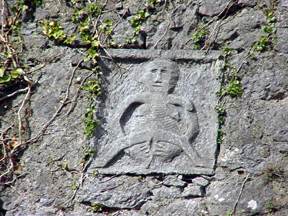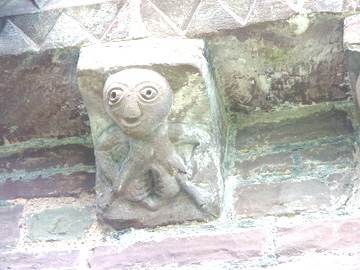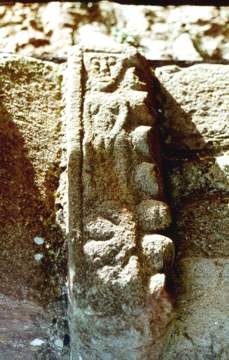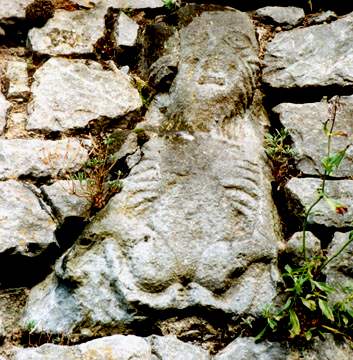|
|
|
|
|
|
 The Woodland League |
|
|
Shae Clancy Researcher, Hunt Museum, Limerick
Sheela-na-gigs are stone carvings of naked females that use one or both hands to direct the viewer's attention to their genital area. Although some were carved in the 12th century, they did not come to the attention of scholars until about 1840. There has been much debate about their origin, meaning and role since then. This essay is an attempt to gather some of the current views on these figures that are an important but neglected component of European and, especially, Irish heritage, and to speculate on their raison d'être.
I use the spelling 'Sheela' throughout, except when quoting published sources.
Origin and meaning of the term 'Sheela-na-gig'
Although it is now a type-name to describe the figures, many had individual local names such as Evil Eye Stone, Hag of the Castle, Witch on the Wall, Julia the Giddy, and St Gobnait.
The term 'Sheela-na-gig' seems to have been adopted as a generic name for female exhibitionists because of some coincidental reports during the early 1840s in Ireland. R. P. Collis, a member of the Royal Society of Antiquaries of Ireland, reported that a 'rude carving' on a church wall at Rochestown, Co. Tipperary, was called a 'Sheela-na-gig by the country people.' [1] 
Dunaman Co Limerick About the same time, Johann Kohl, a German visitor to Ireland, recorded some aspects of Irish folklore. He noted the prevalence of the fear of the 'evil eye' among the Irish and recorded that a man who believed he was afflicted would resort to the services of a certain type of woman. According to Kohl:
It seems clear that the term referred not only to the stone carvings themselves but also to real live women who displayed their private parts in order to avert evil.
However, the term was recorded long before the carved figures came to the attention of 19th c. antiquarians.
In 1781, the French captured a British naval vessel, HMS Shelanagig, in the Caribbean and, around the same time, 'Sheela-na-gig,' with variations of the spelling, was the name of a dance tune that appeared in Scottish, English and Irish publications. The tune is identified as Irish in each case [3]
In 1676, two Irish Church regulations ordered the burning of obscene carvings of naked women and, even earlier in 1631, provincial statutes for Tuam, Co. Galway, ordered parish priests to hide away such carvings and 'take note of where they were hidden.' [4] Although the church regulations don't use the term, it is very possible that the figures referred to were those known today as sheela-na-gigs. The order to 'burn' them suggests that some were made from combustible material.
As for the meaning of the name, Eamonn Kelly is of the opinion that it comes from the Irish language, although he admits its meaning is uncertain. [5] He suggests it is derived from Sighle na gCíoch (the old hag of the breasts) or Síle-ina-Giob (the old woman on her hunkers).
The 'old hag of the breasts' seems unsafe because, although some Sheelas have well-defined breasts, they are in a minority. Many Sheelas have either vestigial breasts or none at all. The most famous of all Sheelas, at Kilpeck in Herefordshire, U.K., is almost entirely lacking a torso!

Kilpeck 'Old woman on her hunkers' might be more acceptable because many Sheelas are depicted in a squatting position. However this explanation is also somewhat unsatisfactory because not all Sheelas are squatting. Some, such as that at Liathmore, Co. Tipperary are either sitting or standing.

Liathmore Jack Roberts is of the opinion that the term 'sheela' or Síle means "femininity" but it also describes a special kind of woman: a Hag or Spiritual Woman perhaps of the Sidhe, inhabitants of the Irish Otherworld.[6]
None of these explanations addresses the most obvious feature of Sheelas: the often grossly exaggerated vulva.
Among numerous modern Irish slang terms that refer to the vagina is gee (with a hard 'g'). Dictionaries of slang and obsolete English and Scottish words define gig, gigg and geig as 'pudenda muliebria,' 'a woman's privities' or 'the vulva.' 'Sheela-na-gee' could then be interpreted as the 'Hag of the vulva,' [7] which describes the figures more accurately than the other explanations.
Origin of Sheelas
Conventional wisdom suggests that Sheelas had their genesis in the exhibitionist carvings that adorn 11th and 12th century Romanesque churches on Continental Europe. Among the many exhibitionists that warn against the sins of the flesh are naked (often voluptuous) women in compromising situations, adulteresses, ithyphallic men, misers, musicians with bestial faces and contortionists with exposed anus. These sinners are usually in the company of others of their ilk in, for example, depictions of the Damned in Hell.
Pilgrims to Compostella or Rome were confronted by these images at almost every stop on the journey, and wealthy English patrons had some of them incorporated in churches on their return from pilgrimage. There is general acceptance that these exhibitionist figures were then brought to Irish churches by the Normans.
The earliest surviving carving of an Irish Romanesque exhibitionist is on the chancel arch of the Nun's Church. Although often described as a Sheela, it is an acrobat or contortionist and is not a Sheela. [8] However, its presence on a pre-Norman Irish structure casts some doubt on the conventional theory that the Normans introduced exhibitionists to Ireland.
Irish Sheela-na-gigs, although undoubtedly exhibitionist, have characteristics that distinguish them from the sinners portrayed on Continental churches. Continental female exhibitionists are almost always in the company of other sinners, are anatomically correct, and most are inside churches. Insular Sheelas in their original location are always solitary and are often anatomically distorted. The heads of many are triangular with protruding eyes and ears, and grotesque mouths that display either an ugly array of teeth or a toothless grimace. Most are bald and some have deeply incised rib cages, features associated with aged hags. However, their arms and legs are often those of a young woman.
Unlike Continental exhibitionists, insular Sheelas are almost always on the outside of churches. Perhaps significantly, they are not confined to churches but also appear on Irish secular tower houses dating from the 13th to the early 17th centuries. Most, whether on churches or secular structures, are at or near an entrance or other threshold. They are, therefore, liminal, being deliberately positioned on a boundary between one place or state and another.
Using these criteria to distinguish between medieval Continental exhibitionists and Sheelas, there are, or are records of, at least 110 Sheelas in Ireland, about 30 in Britain, and only a few on the Continent.
It is curious that of all the different types of exhibitionists seen by pilgrims to the continent, only Sheela-type figures were to become popular in Ireland and Britain. [9] Is it conceivable that Sheelas were not of continental origin?
Helen Hickey acknowledges 'the likelihood . . . that the idea behind these strange carvings germinated in France,' but suggests 'the possibility that the traffic of ideas was in the opposite direction should also be considered.' [10]
Three Irish stones that have Sheela-like carvings provide some support for this latter thesis. Although impossible to date with certainty, the carvings are undoubtedly pre-Norman and two - at Tara, Co. Meath, and Stepaside, Co. Dublin - are much earlier.
A stone in the graveyard on the Hill of Tara bears a carving in relief of a human shape that has Sheela-like features. [11] However, the carving is too badly weathered to make out much detail and, as there is a suggestion of head adornment, it may represent Cernunnos, a Celtic horned god, and not a Sheela.
The status of the Stepaside figure as a Sheela is also questionable. Andersen describes it as 'a massive figure, standing with hands joined around a hidden pudenda.' [12] This figure, like the one at Tara, is on a free-standing stone in the shape of a cross which suggests to Roberts that it is '. . . of the early Christian type. . ' possibly earlier than the 8th century. [13]
The Swords, Co. Dublin, Sheela is also on a pillar, used until recently as a gatepost. Its origin is unknown but Kelly suggests it 'may have originally flanked the doorway' of one of a number of nearby ruined medieval buildings.[14]
Although there is no reliable evidence to suggest that Sheela-type figures pre-date continental Romanesque origins, these three carvings indicate enough circumstantial evidence to warrant further investigation.
Such widespread use of the symbol in Ireland suggests that their role and function must have been of some significance to those who continued to commission them over such a long time and, since a few candidate prototype Sheelas survive in Ireland, it is at least possible, if not probable, that Sheelas are of Irish, rather than of Continental origin.
Function
Barbara Freitag's succinct summary shows the widely varying range of functions popularly attributed to Sheelas. In her more recent publication, she makes a very strong case that they belong to the realm of folk religion relating to birth and associated traditions in rural Irish settings. [16]
The two most widely held theories - and they are theories - concern the apotropaic and fertility functions. As noted earlier, the evil eye, and ways to avert it, preoccupied the rural population of early 19th century Ireland. On the other hand, there is ample evidence, even today, of Sheelas being scraped or rubbed as a supposed cure for barren women.
Irish legends provide several examples of the apotropaic power of the naked female body.
The best known story of the 'pangs of Ulster,' whereby the men of Ulster were afflicted with the pains of childbirth when Ulster was threatened, concerns Macha, a woman of the Sidhe, who was forced to race the king's horse while in the throe's of childbirth. Having won the race, she immediately gave birth and, at the same time, cast the vengeful curse on the men of Ulster.
A different version of the curse concerns CúChulainn. After he had lived for a year with Fedelm of the Long Hair, also of the Sidhe, the Ulster warriors were sent to capture him and return him to Emain Macha. As they approached, Fedelm 'appeared naked before the men of Ulster and, from the sight, they were afflicted with this strange disease.' [17]
On a different occasion, CúChulainn was still in his battle fury on his return to Emain Macha after a foray into Leinster. A sentry espied a 'man on a chariot advancing on us. He'll spill the blood of the whole court unless you see to him and send naked women to meet him.' [18] The naked women confronted him at the entrance to Emain Macha and the sight of them shamed CúChulainn enough to calm his fury, thereby averting the danger. Of interest is the immediate reaction of the sentry to summon naked women, as if that was the appropriate action to take in times of danger.
We have already seen that one of the principal attributes of Sheelas is their liminality - their location at or near vulnerable thresholds such as entrances. One of the Sheelas in Fethard, Co. Tipperary, is in the old town wall overlooking the ford that provided access to the town in late medieval times, 'as if placed in a position to overlook the bridge.' [19]
The liminality of some Sheelas is not so readily apparent. Some, such as that at Clenagh Castle, Co. Clare, are on quoin stones. Andersen comments that castles (tower houses) have an intrinsic weak point in the structure. He uses the Ballyfinboy Sheela as an example. 'The progression from the slope of the lower wall into the heights of the keep has its weak point. To employ a sheela just there is enlightening, almost like saying that her presence on that wall is a strengthening of it.' [20] Here is a good example of the combination of liminality and the apotropaic function of Sheelas. She is liminal because of her position at the threshold of two different states - weakness and strength - and protective because of her deliberate insertion between those two states. Andersen goes so far as to say that 'the Ballyfinboy sheela speaks for her whole breed and their "magic" use as mainly apotropaic figures.' [21]
Their function as fertility symbols is the other most common popular explanation of the role of Sheelas. However, if Sheelas are of Irish or Celtic origin, it is likely that human fertility was not their original function since all such symbols known to date, such as the Turoe Stone in Co. Galway and the mis-named Lia Fáil on the hill of Tara, are phallic.
In Irish legend, fertility of the land and of the people, the tuath, rather than of the individual, was paramount. The king's survival depended on the success of his reign in terms of fecundity of cattle and crops, and his success or failure was determined by Sovereignty, the female personification of the Land.
An example can be found in the story of 'The Destruction of Da Derga's Hostel,' which concerns the reign of Conaire as King of Erin. Sovereignty is described near the beginning of the story:
Later in the story, when Conaire's reign proves disastrous, Sovereignty reappears in a very different light.
In other stories, such as that of Niall Nóigiallach (Niall of the Nine Hostages,) Sovereignty appears first as an ugly hag who later changes into a beautiful woman when the rightful king accepts her.
There are many more examples but these suffice to show that Sovereignty could appear either as a beautiful young woman or as a hag. As noted earlier, many Irish Sheelas share features of both youth and advanced age, with arms and legs of a younger woman, and face and torso of a hag.
It is possible, then, that Sheelas combining features of hag and young woman represented the concept of Sovereignty to the early Irish. Their presence on secular structures such as tower houses and bridges may have been recognition of Sovereignty's role as protector.
If this is the case, we are still left with the problem of their appearance on Irish churches in the 12th and subsequent centuries. It seems most unlikely that the Church would have tolerated such pagan depictions unless they could be re-interpreted in a Christian context. There is a deal of evidence that this is precisely what happened. Early Christianity encouraged Christianisation of pagan deities and inclusion of pagan festivals in the Church calendar so that the transition from paganism to Christianity would be as painless as possible for the converts. [25] Hagiographies of Irish saints, especially those of St. Brigid, attest to this adoption process. [26] Freitag shows that 'such syncretism between an older religion and Christianity survived for a considerable time.' [27] She suggests that Sheelas represented some 'powerful idol or deity that had to be tolerated by the early [Irish] Church because it was too popular among the people to extinguish.' [28]
Although the medieval Irish Church was often castigated by Rome for its continued tolerance of pagan practices, it seems highly unlikely that it would sponsor a depiction of a pagan deity over the entrance to a place of Christian worship just because of its popularity. It is more likely that, recognizing the popularity of the figure, the Irish Church Christianised it by adopting it as a symbol of birth and rebirth. The exaggerated vulva demonstrated birth into this world but, by passing under the figure into a holy place, it also represented a symbolic entry to the womb of Christianity (Mater Ecclesia) and re-birth into the True Faith. The emaciated and aged features of the face and torso reminded people of their mortality and the certainty that their only hope for eternal life lay within Mother Church.
Unfortunately, there is no direct support for such speculation in Irish literature. Lack of any reference to Sheelas in medieval Irish texts indicates that they were either commonplace and didn't merit comment or that they did not exist when the Annals were being written. The latter seems unlikely because some Annals were written during the 16th century when Sheelas were still being incorporated into church and secular structures, and there is no mention of them in any other texts written between the 12th and 16th centuries. The alternative explanation, that they were undeserving of mention because they were so commonplace, derives some support from the 17th century Episcopal instruction to "burn" Sheelas. This suggests that Sheelas made from combustible material were indeed commonplace and that the surviving stone carvings represent just a small proportion of those that once existed. Although the Annals and other medieval texts provide no evidence for their existence, Irish folklore abounds with references to mysterious entities that may provide a clue.
Sheelas in Irish folklore
Underlying the undoubted acceptance of Christianity by the Irish is a continuation of pre-Christian belief. Magical beings such as the banshee have been part of Irish culture since records began.
Westropp quotes accounts of three banshees described in Cathreim Thoirdhealbhaigh ('Triumphs of Turlough'), written about 1350:
Depictions of Sovereignty may well have survived into the 19th century in the form of Brídeógs. Effigies of St. Brigid were carried from house to house on the eve of the saint's feast (1 February). Sometimes a child's doll was used but often the image was made of straw.
Brigid (Brigit) was a pre-Christian Celtic goddess who was adopted by the early Irish Church and who is sometimes equated with Sovereignty. Douglas Hyde notes that 'several attributes of the pagan Brigit. . . passed over to her Christian namesake. [31] These attributes included liminality and fecundity of cattle.
Evolving Sheelas?
The earliest Irish Sheela-like figures, such as those at Tara and Stepaside, are very weathered and it is impossible now to see anything other than that they seem to be using their hands to draw attention to the genital region. It is equally impossible to say with certainty that they are even female but the absence of any obvious male attributes lends credence to the probability that they are not male.
The earliest 'true' Sheela, according to our earlier definition, is at Liathmore in Co. Tipperary. She is beautifully carved but does little other than indicate the location of her genital area. It is only later, from the 13th century onwards, that Sheelas develop, in modern parlance, 'attitude.' The figures at Cashel, Doon Castle and Killinaboy, for example, are stocky with broad shoulders and large heads. Although they point to the vulva, their threatening posture is notable. Other figures, such as those from Seir Keiran and Cavan, seem uglier with a more pronounced vulva and a face distorted by carved incisions that could represent worry likes. The Fethard Sheela, with her deeply engraved facial grooves, epitomises agonized aggression caused by desperation. Later figures, such as a Clenagh Castle, are almost caricatures of the Sheela figure. 
Fethard The earlier, more benign figures, pre-date the arrival of the Normans in Ireland. Most of the threatening, protective Sheelas date from the first couple of centuries after their arrival, when the Normans were extending their sphere of influence. The later Sheelas with worried expressions date from the 15th and 16th centuries when English rule had almost eliminated the old Irish tradition. The caricatures, memories perhaps, were carved after the Flight of the Earls, which marked the end of the old Irish order at the beginning of the 17th century.
The artists who carved Sheelas were trained in the tradition of those who made the High Crosses during the 9th and subsequent centuries. Although most panels on High Crosses depict scenes from the Scriptures, some show contemporary images such as musicians, processions and warriors on chariots, indicating that the artists were not averse to including secular motifs on ecclesiastical monuments. [32] There is little doubt that the clergy would not have permitted such secular depictions unless they had special significance. We have already seen that, despite the adoption of Christianity by the medieval Irish, pagan traditions such as Brídeógs continued into the 19th century, if not later, even though their origins were forgotten by then. It is possible that the concept of Sovereignty, depicted as Sheela, was one of those traditions that endured.
Summary
I hope to have shown that Sheelas should be excluded from the holistic term 'exhibitionist figure' and that they should be regarded as separate entities because of their special characteristics. They were, in my view, depictions of a goddess who protected her Land from abuse. As a consequence, she provided protection to those who used the Land wisely and caused the destruction of those who failed her. Her protective function is indicated by her position at boundaries and by her posture. Her fertility aspect concerned productivity of cattle and crops, rather than of human fertility. As with many other pre-Christian concepts, she was adopted by the Church. Her disappearance as a carved image after the 16th century is possibly due to the demise of the old Irish order and its replacement by a different political and religious system. Nevertheless, traditions derived from the concept of Sovereignty may still be seen in some recent festive activities, although their origins are now forgotten. 1.Jorgen Andersen, 'The Witch on the Wall, Rosenkilde and Bagger, Copenhagen, 1977, p. 11 2. ibid, p. 23. (Thanks to David Stifter for translation from the German passage in Andersen's book) 3.Barbara Freitag, "A New Light on the Sheela-na-gig," Éire-Ireland, The American Cultural Institute, Fall/Winter1998 & Spring 1999, XXIV: 1, p. 65 ff. 4.Freitag, p. 69. 5. Eamonn Kelly, "Sheela-na-gigs: Origins and Functions," Country House, Dublin, in association with the National Museum of Ireland, 1996, p. 5 6. Jack Roberts, "The Sheela-na-gigs of Britain and Ireland: an illustrated guide," Key Books Publishing, Skibbereen, Cork, p. 8 7.Freitag, p. 67 8. Jacqueline O'Brien and Peter Harbison, "Ancient Ireland: from prehistory to the middle ages," (London, 1996), p. 122 9. Freitag, p. 57 10.Helen Hickey, "Images of Stone," Blackstaff Press, 1976, p. 57 11. "The arms seem joined together in a vaguely discernable gesture towards the abdomen," Andersen, p. 152 12. Andersen, p. 152 13. Roberts, p. 31 14. Kelly, p. 40 15. Freitag, p. 50 16. Barbara Freitag, "Sheela-na-Gigs: unraveling an enigma," Routledge, 2004 17. Marie-Louise Sjoestedt, "Gods and Heroes of the Celts," (Myles Dillon's translation), Methuen & Co., London, 1949, p. 27 18. Thomas Kinsella, "The Tain," Oxford University Press, 1970, p. 91 19. Andersen, p. 135 21. Andersen, p. 107 22. Tom Peete Cross and Clark Harris Slover, "Ancient Irish Tales", Barnes & Noble, New York, 1996, p. 94 (originally published by Henry Holt and Company, Inc., 1936) 23. Translated by more recent writers as 'pubic hair.' 24. Cross and Slover, p. 107 25. Freitag, p. 68 26.See Liam dePaor, "St. Patrick's World," Four Courts Press, Dublin, 1993, for hagiographies of early Irish saints. 27. Freitag, p. 68 28. Freitag, p. 68 29. Westropp, p. 7 30. Kevin Danaher, "The Year in Ireland," Mercier Press, 1972, p. 24 31. Douglas Hyde, "A Literary History of Ireland," T. Fisher Unwin, 1899, republished by Ernest Benn Ltd, 1967, p. 161 32. For a good overview of sculpting on Irish High Crosses, see H.S. Crawford, "Irish Carved Ornament," reprinted by Mercier Press, 1980
|